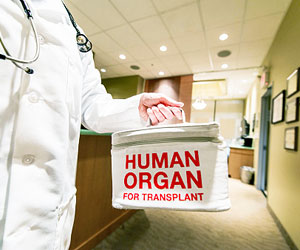Medical Resources Allocated Equally Across Groups, but More Efficiently Across Individuals
People make dramatically different decisions about who should receive hypothetical transplant organs depending on whether the potential recipients are presented as individuals or as part of a larger group, according to new research published in Psychological Science, a journal of the Association for Psychological Science. The findings show that when recipients are considered in groups, people tend to allocate organs equally across the groups, ignoring information about the patients’ chances of success.
 “This is important because public policies about prioritizing resources are framed at the group level — for example, younger recipients are prioritized for the best transplant organs — and yet actual allocation decisions are often made at the individual level,” explains psychological scientist and senior study author Gretchen Chapman of Rutgers University.
“This is important because public policies about prioritizing resources are framed at the group level — for example, younger recipients are prioritized for the best transplant organs — and yet actual allocation decisions are often made at the individual level,” explains psychological scientist and senior study author Gretchen Chapman of Rutgers University.
“The intuitions that guide people’s discussions about the policies might not be the same as the intuitions that are most salient when it comes time to take an individual allocation action.”
In collaboration with first author Helen Colby (Anderson School of Management, University of California, Los Angeles) and co-author Jeff DeWitt (Rutgers University), Chapman asked 470 participants in an online study to allocate six kidneys across a total of 12 hypothetical patients.
Headshot-style photos of the patients were presented in a grid that had a vertical line running down the middle, with 6 patients on either side of the line. Some participants saw “Chance of Success: High” written over top of the right side and “Chance of Success: Low” over the left. For other participants, the same information about chance of success was written instead under each individual patient photo. Also, some participants made a decision about how many kidneys to allocate per group, while others had to decide whether to allocate a kidney to each individual patient.
The most medically efficient decision — the one with the likelihood of saving the most lives — would be to allocate all 6 kidneys to the patients with a high chance of success. But the researchers hypothesized that presenting the patients in groups might lead people to make less efficient decisions.
As expected, participants made more efficient decisions when the chance of success was presented for each patient compared to when it was presented for the two groups; patient-by-patient allocation decisions were also more efficient than those made by group.
In two additional online studies, some participants saw a unified group of 12 patients, while others saw two groups of six patients divided by a line (as in the first study). Again, presenting patients as part of groups had a noticeable impact on participants’ allocation decisions:
“It’s surprising how such a subtle manipulation shifted participants’ responses,” says Chapman. “Just drawing a line down the middle of the screen to separate the 12 recipients into two groups of six and putting a label over each group was enough to make participants less efficient in their allocation.”
The findings showed a robust grouping effect, regardless of the types of labels used to identify the groups and the amount of information provided about the potential recipients.
“The grouping effect was resistant to a number of different variations in the procedure that we tried,” says Chapman. “We used different type of group labels, we used group labels that were completely uninformative, and we removed the identifying information about the recipients, but none of these procedures reduced the grouping effect.”
Together, these findings suggest that people have a strong bias toward equality when it comes to divvying up limited resources, even if equality doesn’t ultimately lead to the most logical or effective decisions. There are some contexts, however, in which the grouping effect could be helpful:
“If managers making decisions about hiring or promoting employees were to have candidates grouped by gender instead of presented as individuals, they might be prompted to spread jobs across the groups more evenly, which would lead to the hiring or promotion of more women,” explains Chapman.
The researchers plan on exploring the potential positive outcomes of grouping in future studies.
This research was supported by National Institute on Aging Grant 1R01-AG037943-01 (to G. B. Chapman).
All data and materials have been made publicly available via Open Science Framework and can be accessed at https://osf.io/wk3ve/. Study 3 was preregistered at https://osf.io/k29e6/. The complete Open Practices Disclosure for this article can be found at http://pss.sagepub.com/content/by/supplementaldata. This article has received badges for Open Data, Open Materials, and Preregistration. More information about the Open Practices badges can be found at https://osf.io/tvyxz/wiki/1.%20View%20the%20Badges/ and http://pss.sagepub.com/content/25/1/3.full.





APS regularly opens certain online articles for discussion on our website. Effective February 2021, you must be a logged-in APS member to post comments. By posting a comment, you agree to our Community Guidelines and the display of your profile information, including your name and affiliation. Any opinions, findings, conclusions, or recommendations present in article comments are those of the writers and do not necessarily reflect the views of APS or the article’s author. For more information, please see our Community Guidelines.
Please login with your APS account to comment.